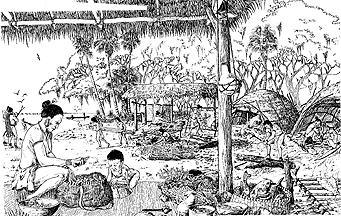Yat Kitischee – What Is Archaeology?
Archaeology is the study of past cultural behavior, from the beginnings of the human species to events that happened yesterday, through the material remains, or artifacts, that people leave behind. By carefully applying scientific techniques in excavation and analysis of their findings, archaeologists attempt to reconstruct past lifeways and understand why different customs developed and evolved.
Archaeologists also hope to gain a better understanding of the native Floridians as a people. To do this, they try to assemble clues that help answer questions about their religious beliefs, their political systems and their family structures. Unfortunately, games, jokes, songs and dances do not preserve in the ground. To help flesh out the details of prehistoric life, archaeologists use historical documents that describe native cultures at the time of Spanish contact and ethnographies of contemporary traditional societies in places like Africa, Australia and South America. These provide insights into the kinds of social behaviors that might have been practiced in the past by people possessing similar levels of economic and political development.

Why Study the Past?
At Yat Kitischee, native peoples had to solve everyday problems that confront people everywhere – the necessities of obtaining food and shelter, protection from the elements and learning to coexist with family members and neighbors. Because the site was occupied for over 1000 years, people also had to respond to long-term problems such as increases in population, the depletion of resources and climatic change. These too are universal problems. Through archaeology we come to understand that there are many different ways of dealing with these problems, and we gain an appreciation for the variety of customs, beliefs and lifestyles that are present within the human species.

Why Does Culture Change?
What is Culture?
Specific cultures develop in response to the opportunities and constraints presented by their local environments. As the environment changes, so do the ways in which people adapt to and exploit it. For example, the houses, clothes and diet of people living in a desert are very different from those of people who live in the arctic. Because the environment has changed through time, the distant ancestors of people who today live in a desert may have been confronted by dense forest and abundant water requiring a much different lifestyle. The ability to develop culture has enabled the human species to adapt more quickly and efficiently than it could if it was dependent only on changes to its genetic makeup which occur at a much slower rate.
But people don’t only adapt to the natural environment. They interact with other people, and these interactions constitute their social environment. In the past, as populations increased in size, social and economic interaction with different people became more frequent and complex, further influencing the character of local cultures. Culture change is thus influenced by both environmental and social factors.